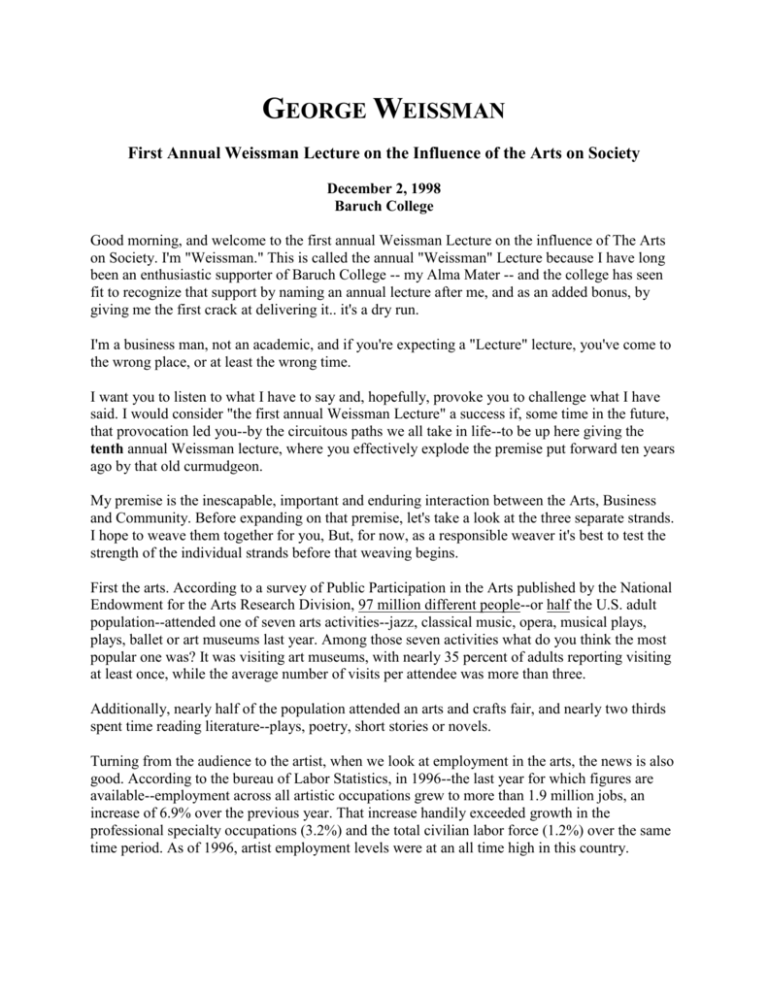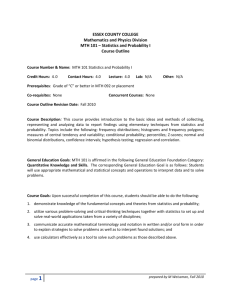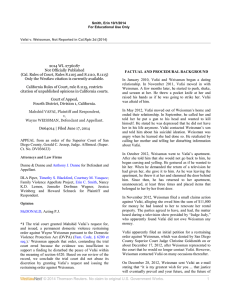First Annual Weissman Lecture on the Influence of the Arts on Society
advertisement

GEORGE WEISSMAN First Annual Weissman Lecture on the Influence of the Arts on Society December 2, 1998 Baruch College Good morning, and welcome to the first annual Weissman Lecture on the influence of The Arts on Society. I'm "Weissman." This is called the annual "Weissman" Lecture because I have long been an enthusiastic supporter of Baruch College -- my Alma Mater -- and the college has seen fit to recognize that support by naming an annual lecture after me, and as an added bonus, by giving me the first crack at delivering it.. it's a dry run. I'm a business man, not an academic, and if you're expecting a "Lecture" lecture, you've come to the wrong place, or at least the wrong time. I want you to listen to what I have to say and, hopefully, provoke you to challenge what I have said. I would consider "the first annual Weissman Lecture" a success if, some time in the future, that provocation led you--by the circuitous paths we all take in life--to be up here giving the tenth annual Weissman lecture, where you effectively explode the premise put forward ten years ago by that old curmudgeon. My premise is the inescapable, important and enduring interaction between the Arts, Business and Community. Before expanding on that premise, let's take a look at the three separate strands. I hope to weave them together for you, But, for now, as a responsible weaver it's best to test the strength of the individual strands before that weaving begins. First the arts. According to a survey of Public Participation in the Arts published by the National Endowment for the Arts Research Division, 97 million different people--or half the U.S. adult population--attended one of seven arts activities--jazz, classical music, opera, musical plays, plays, ballet or art museums last year. Among those seven activities what do you think the most popular one was? It was visiting art museums, with nearly 35 percent of adults reporting visiting at least once, while the average number of visits per attendee was more than three. Additionally, nearly half of the population attended an arts and crafts fair, and nearly two thirds spent time reading literature--plays, poetry, short stories or novels. Turning from the audience to the artist, when we look at employment in the arts, the news is also good. According to the bureau of Labor Statistics, in 1996--the last year for which figures are available--employment across all artistic occupations grew to more than 1.9 million jobs, an increase of 6.9% over the previous year. That increase handily exceeded growth in the professional specialty occupations (3.2%) and the total civilian labor force (1.2%) over the same time period. As of 1996, artist employment levels were at an all time high in this country. Of course, making a living as an artist often continues to be a difficult proposition here as elsewhere. Even success as an artist is sometimes not immediately rewarded. There is a story about Degas, who once witnessed one of his paintings sold at auction for $100,000, a spectacularly huge sum in his day. Asked how he felt, he said, "I feel as a horse must feel when the beautiful cup is given to the jockey." What are people paying to experience art? Here's a snapshot of the performing arts. According to the Bureau of Economic analysis, American consumers spent more than $10 billion on admissions to performing arts events last year. How do the performing arts stack up to, say, movies or spectator sports? The bureau of Economic Analysis looked at that too, and found spending on performing arts was roughly 1.6 times larger than spending on either admissions to motion pictures or spectator sports events. By several measures, then, the arts in this country seem to be doing pretty well. And they should be because arts are the lifeblood of our being as individuals or a community. The earliest means of communication were the cave paintings and ritual music. Without the arts we would still be swinging from the trees. They distinguish us from other forms of life on earth. Turning from art to business, business seems to be doing just fine. The stock market reached an all time high in November. Unemployment is low, interest rates are low, and these major indicators also speak for a strong economy. Business, of course, runs in cycles, but in general, the economy has been very robust over the past seven years; it bounced back from a dive earlier this year that normally would have taken much longer to recover from, and it has continued to grow in the face of dire predictions to the contrary. It is difficult to assess "community" in the quantitative terms I've applied to the arts and business. In general, I am encouraged by several trends. We have seen a move back to urban centers that began to be abandoned starting in the sixties. National and urban crime figures are down. Significantly, we have experienced a shared national realization that we are not only the great melting pot that served as the American metaphor in the first half of this century, but we are also diverse--probably the most diverse nation that has ever existed on the face of the earth. And there is remarkable strength in that diversity as long as we respect each others' differences. In summary, our communities and our sense of community seem to be improving, especially as compared to the period stretching from the 60's to the early 90's. One of the fascinating movements behind the rebirth of the urban society has been the rebirth of the arts in urban settings. It's fascinating to watch Newark, New Jersey suddenly coming to life with the construction of the New Jersey Center for the Performing Arts. In our own New York City the arts created three whole new areas: Tribeca, Soho, and of course Lincoln Center. In Winston-Salem, North Carolina the arts rejuvenated a whole inner city. I could cite many others but it could be your own research project. When I broach the topic of the interdependence between the three strands--Arts, Business, and Community--people often resist, feeling that there are natural limits on the focus--that if you're interested in the arts, well, there might be a link to the community but certainly not to business. Or, if your focus is on the community, you might seek a public/private partnership with business, but to talk about art in that context would be superfluous. I have spent a good part of my professional life trying to convince people that when it comes to the Arts, Business and Community--each make a significant contribution to the other, and all three combine to the great advantage of each. They are mutually supportive and are in no way mutually exclusive. They all interact with each other. Their interaction is vital to our basic humanity. I call this ABC interaction--this mutually reinforcing set of interdependencies between Art, Business and Community--the "Triple Helix." And if that description reminds you of the double helical structure of DNA discovered by Watson and Crick forty five years ago, I mean it to. The triple helix--the Weissman model of three important, interacting elements of our culture--is, in a very real sense, just as essential to our humanity as is our DNA. Each of the three strands--Art, Business and Community--wind around each other to make a single strand and that strand weaves into a tapestry that defines us, gives our lives meaning and enriches us beyond measure. Each strand supports the others. The arts cannot do without business, which provides financial support and opportunity. The arts cannot do without the community, which provides the stimulus and the stage, the performers and the audience. The community cannot do without the arts, which provide a sense of purpose and enrich the quality of life. And the community cannot do without business, which provides for its jobs, taxes, revenues, well-being, vitality and cohesion. Business cannot do without the community, which provides its employees, suppliers and marketplaces; in fact, the reason for its existence. And finally, business cannot do without art. It will spend most of the rest of my time here expanding on that contention. I maintain that these strands--the arts, business and community--while completely different, contribute equally to the final, triple helix they produce. Here, again, I sometimes find resistance to this idea. Often, especially when we assess the emotional, feeling or intuitive sides of our lives, "business" would appear to be the odd man out. That is, business would seem to be the most distant from the feeling of human fulfillment and transcendent experiences we strive for. Not so with art. When we talk about our own "experience" of "Art," it is precisely very personal, emotional and intense. Something in a performance, something we read or look at, grabs us and twists our heart in such an indelible manner that we remember that moment, and from then on that nodal experience serves as a benchmark for the rest of our experience. Similarly when we talk about "Community," we're referring to the entire social support system that we have developed as human beings over the millennia--the infrastructure as well as the social interactions that provide us with the deeply longed for feeling of belonging. But, when we talk about "Business" in general, well, it seems colder--" buy cheap and sell dear," "caveat emptor," or Cal Coolidge's famous dictum, " the business of America is business." It was Coolidge who also said, "Civilization and profits go hand in hand." And when we include corporate America in the discussion, for most people things seem to get colder still, if that's possible--with the perception that corporations have a single-minded focus on the bottom line, the stock price, share volume and growth, and not much else. Think of the image immediately generated in your mind by the word "corporation," or simply take any convenient noun and put "corporate" in front of it and consider the implicit value judgment that accrues to the result--" corporate mentality," "corporate ethics," "corporate wife." It is no coincidence that any cursory scan of the mass media--books, TV, magazines, you name it--on who and what is portrayed as "the bad guy," reveals that corporate America is a significant source of inspiration. While I'm not here to try to change the semantics associated with U.S. corporations, I would like to offer for your consideration a few facts about the link between corporate life, the arts, and our sense of community that I know to be true. As I noted earlier, starting in the 1960's, the United States began to experience turbulent changes on many fronts--politically, economically, socially, culturally--indeed, many of the pressure waves can still be felt today. Established cities like Boston, Cleveland, Atlanta, Pittsburgh and scores of others showed serious signs of wear and tear. The term " rust belt" came into common usage among economic analysts. There were other revolutionary changes taking place at the same time--in automation, computerization, communication, miniaturization, transportation and so on. These sweeping changes threatened the ideological core of the 50's business mentality, where the rule was "if it ain't broke, don't fix it," and where stability was the norm. Since traditional means of doing business could not cope with the new conditions--a world not only of change but of accelerating change--innovative approaches were needed to make secure our democratic capitalist way of life. In business--that is, successful businesses, the ones that survived and prospered--the rule changes from " if it ain't broke, don't fix it," to "if it ain't broke, break it!" And one of the places where American business "broke it" and "broke out" of traditional, conservative thinking was in its attitude toward the arts. Business leaders, who in the past had separated the arts from business, reversed themselves and embraced the arts as a source for the creativity we needed to stimulate social and economic progress. We tapped into--and fed on--the American people's boundless appetite for the arts. At Philip Morris, we were right in the middle of this turnaround. We were a small company then, the smallest among the six major tobacco companies in the U.S. Still, we were in the mass consumer marketing business, and we soon learned that our association with the arts seemed to improve our ability to communicate with people everywhere--and let our employees know that we were receptive to new ideas, their ideas. Our initial focus was, not surprisingly, on visual art. Our reasoning behind our support of the visual arts and then the other art forms we began to support was that we needed stimuli that would force us to look at everything we did in a completely new manner. All day long, in all phases of our operation, from product design to packaging, from promotion to advertising, we were dealing with lines, movement, design, color, shape, themes, texture and content. The arts were our advance scouts. In our endless search for innovative development of quality products, we felt that we needed to become alert to the art forms and expressions that most strikingly challenged our creative imagination--that enhanced our ability to communicate with great numbers of people in an era of increasingly sophisticated and complex visual and verbal imagery. We never regarded art as a gimmick for quick, short-lived publicity. For us, art was a restless, probing presence to help convert us into a creative mass marketing organization. We were not interested in cosmetics, but in metamorphosis. Given that objective, we knew that such art could not be incubated solely within our own organization. It doesn't originate in any department or plant area. It arises, in fact, from outside the company--within a community at large of which the company is a part. Therefore, on the narrowest of grounds, in order for our company to flourish, it requires a society in which the arts flourish, in which people can gain a fuller measure of the promises and the pleasures of living. For the stimulus we sought, much of what we supported would probably be considered nontraditional art. We went to auctions and began to buy it, we put it on our walls throughout our offices in our New York headquarters, and also in our manufacturing centers, where everyone had access to it. We began to support the artistic community in a non-judgmental fashion that was very much more on the edge than you could possibly imagine a corporation supporting. That support continues to this day--we have been the major supporter of The Next Wave performance art festival at the Brooklyn Academy of Music. Given our decision to seek stimulus from the world of art, we did not and do not approach any arts organization or individual with the suggestion that they do this, that or the other thing. We never tell, suggest, hint or imply who or what. It's not our business or area of expertise. In return they don't tell us how to prepare, package, advertise, promote and sell our products. We're both happy with this arrangement. We learned quickly that good art is good business. And we learned quickly that good art is good citizenship--that good art contributes to the quality of life in the community. As we increased our support, we found that most people appreciated what we did, and even revealed a strong belief that American business should support cultural activities as part of its corporate social responsibility. And perhaps most importantly we signaled to our employees that management is always open to new ideas, new thoughts, new ways of carrying out our business. Arts support has made us better corporate citizens, more sensitive to the interests and needs of the communities where we do business, and where our people and their families live. And what about the community itself? Well, I've got a story to make that connection also. A decade ago, Philip Morris sponsored an unusual exhibition called "The Vatican Collection" at the Metropolitan Museum of Art. It was by every measure a great success, pulling record numbers of visitors from all over the country and indeed the world. One measure of the positive impact on the community--in addition to access to extraordinarily rare, beautiful and valuable works of art-was that the exhibition, on its own, was estimated to have stimulated the influx of $100 million into New York's economy, during a time when that stimulus was very much needed. I knew that the circle had come full round when, years after we initially began our support of the arts, I was Chairman of Philip Morris--which was significantly larger than when I'd first joined it, and was involved in a number of different large industries--and I was reviewing the solicitations from state industrial development agencies. Previously it had been my experience that brochures urging a company to build its manufacturing facilities in a particular area, or to transfer operations to that area, would stress tax advantages, low labor costs and other similar inducements. But there I was, looking at brochures that were selling-in their areas by citing " symphony orchestras, ballet companies, theaters and university campuses." The arts, business and community. In my mind they weave together in a magic thread that expands our experience exponentially, opens us to the newness of others, ourselves and our environments. In a recent speech to the Corporate Council for the Arts, Bill Ivey, Chairman of the National Endowment for the Arts, said, "Our arts reflect our democracy. Bound not by common blood, common culture, race or religion, the arts open avenues of understanding among individuals and communities." I feel very strongly that it is in the enlightened self interest of business to participate in the opening of those avenues by supporting the arts and by taking inspiration from them. In doing so, we take a three stranded thread--art, business and community--and from it we weave the dreams and aspirations of our society. The fabric that we weave from this triple helix is diverse, strong and immediate. It touches us daily, it is a living fabric. I could go on but perhaps the Swedish painter and iconoclast, Claes Oldenberg said it best about this sense of immediacy--about the fusion of our work, community and art that is so important, when he said, " I'm for art that political-erotical-mystical, that does more than sit on its butt in a museum." Thank you.









